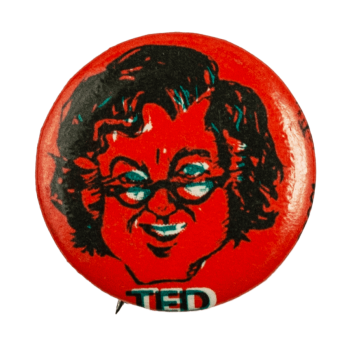| Category | |
|---|---|
| Additional Images | |
| Sub Categories | |
| Text on Button | TED |
| Image Description | Red background with black illustration of a man with blue and white highlights in center of button, and black text with white highlights under the image. |
| Curl Text | [illegiable] CA 95061 |
| Back Style | |
| The Shape | |
| The Size | |
| Year / Decade Made | |
| Additional Information | Starting after the tumultuous 1968 Democratic National Convention, Senator Edward Moore Kennedy, known as ‘Ted’, was regarded as a front-runner to be the Democratic presidential nominee. Despite his party's support, Kennedy refused to enter the primaries in 1972 and 1976—perhaps, for his involvement in the death of Mary-Jo Kopache in a car accident on Chappaquiddick Island in 1969. Nevertheless, on November 7, 1979, senator Kennedy announced his candidacy for the Democratic presidential nomination, challenging sitting president Jimmy Carter. Due to Carter's 25% approval rating among members of his own party, Kennedy was favored by the electoral base and received several party endorsements. Some because of his potential strength, and his commitment to specific liberal policies, while others were driven by frustration with the current administration. Many responded to Kennedy’s experience and capacity for leadership. Moreover, Kennedy’s appeal outside the party included the ability to bring together traditional liberal groups like labor with feminists and civil rights activists. Despite Kennedy's promise, his campaign team was divided and unfunded and he tried to pursue a moderate image that confused the liberal base of the party. In contrast, Carter’s campaign was well organized and pointed in their attacks of Kennedy, brining up the Chappaquiddick incident. That, coupled with the Iran hostage crisis and the invasion of Afghanistan by the Soviet Union, gave Carter a surge in popularity that helped him win the nomination. However, the divisive primary weakened the democrats overall and Carter lost the general election against Ronald Reagan—in part because some Kennedy supporters eventually voted for Reagan. |
| Sources |
Stanley, T. R. (2009, August). “Sailing against the Wind:” A Reappraisal of Edward Kennedy’s Campaign for the 1980 Democratic Party Nomination. Journal of American Studies. 43(2). Pp. 231-253. https://www.jstor.org/stable/40464379 Lynn, F. (1980, March 18). Kennedy's New York Campaign in Severe Disarray. The New York Times. https://timesmachine.nytimes.com/timesmachine/1980/03/18/111142202.html?pageNumber=49 Smith, H. (1979, November 8). Kennedy Declares His Candidacy, Vowing New Leadership for Nation. The New York Times. https://www.nytimes.com/1979/11/08/archives/kennedy-declares-his-candidacy-vowing-new-leadership-for-nation.html BBC. (2016, January 14). Ted Kennedy and the vitriolic 1980 US election. Newsnight archives. https://www.youtube.com/watch?v=ZbOJsjZBgdw |
| Catalog ID | PO1275 |


